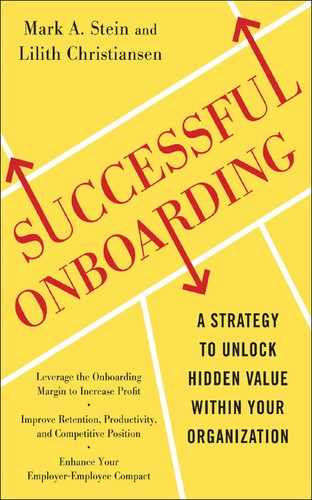CONCLUSION AND
NEXT STEPS
We’ve expressed throughout this book that onboarding is an experience—for the new hire, the hiring manager, and for the enterprise more broadly. We are certain that this experience shapes outcomes, and it is in the best interest of all parties for the experience to be managed with great skill.
To engineer this experience for optimal outcomes, your enterprise will be well served to (1) adopt design principles, (2) be strategic, and (3) be systemic. Successful Onboarding is far more than traditional orientation in new clothes; it is an innovative strategic program that can boost a company’s bottom line and improve its future prospects. By establishing a program covering culture, social networks, early career support, and strategic insight, and integrating onboarding into the infrastructure and processes of a company, you can reduce time to productivity, increase level of productivity, and lower attrition (specifically, regrettable attrition). These measures in turn lead to a clear financial gain—the Onboarding Margin. Tailoring the day-to-day experience of new hires through their first anniversary date, strategic onboarding can produce more satisfied employees and a more productive workforce better aligned with company objectives. In the process, it can produce a stronger, more dynamic, more profitable organization.
With very few exceptions, onboarding remains an untapped promise in business. To realize this promise, the leaders in an organization need to think of onboarding in new ways. HR leaders need to grasp the full opportunity they have before them. The programs need to be focused on far more than efficient administration of paperwork, compliance, and distribution of the tools of the trade; it is a substantial, year-long investment in one of a firm’s greatest assets—its human capital—with raised expectations for return on investment. Hiring managers need to treat onboarding as a real chance to help an organization create the quality workforce it wants and needs. We hope hiring managers reading this book begin to recognize the great opportunity onboarding offers to break the cycle of “hire, attrit, hire” and transform it into “hire, invest, improve, and grow” (personal growth and enterprise growth). Finally, and arguably most important, we hope that business leaders outside of the human resource function will embrace strategic onboarding and pursue the Onboarding Margin with the same passion that they pursue lean manufacturing, six-sigma programs, and other leading management disciplines.
With global business moving ever deeper into a knowledge-based economy, the knowledge worker has become the company’s key asset—more important than production processes and traditional capital investments, especially given that it is the knowledge worker who will help drive the smart investments in new markets, customer service, improved production processes, and capital projects. Business leaders seem to recognize this fact—they talk about people as their most important asset—but they don’t always put their money behind this idea. Onboarding is the neglected stage in the employee life cycle, and it is the most important area deserving of budget today. By pursuing intelligent designs based on proper diagnostics, companies can redefine the employer-employee compact to a mutually beneficial state that supports the modern enterprise in our modern economy that demands flexibility, responsiveness, and continuous improvement at ever-increasing rates.
Realizing the Onboarding Margin throughout an organization is no small task. Yet it’s not a mountain to climb, either. We’d like to conclude by emphasizing that individual hiring managers can make a real difference with onboarding, whether or not their superiors in the organization buy in. Hiring managers can take pieces of the firm-wide onboarding programs we’ve described and implement them on a smaller scale in their departments or divisions. Onboarding doesn’t have to happen all at once, and if worse comes to worse, it doesn’t have to happen everywhere at once.
Take heart. And take charge. With an understanding of onboarding in your back pocket, you can become an effective change agent in your organization. You can empower your employees to put their best selves forward at work, progress their careers, and in the end, drive your business further.
